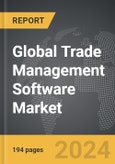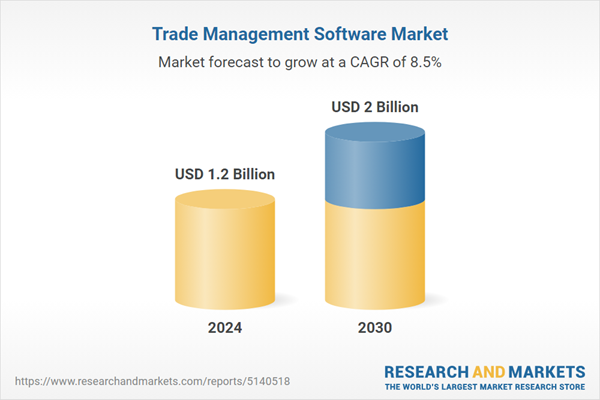Global Trade Management Software Market - Key Trends & Drivers Summarized
What is Trade Management Software and Why is it Crucial?
Trade Management Software (TMS) is a comprehensive digital solution designed to streamline and automate the complex processes involved in international trade. This software encompasses a range of functionalities, including import and export management, compliance with trade regulations, tariff and duty management, and global logistics coordination. TMS solutions are vital for businesses engaged in cross-border trade, as they ensure regulatory compliance, reduce operational costs, and enhance overall efficiency. By automating manual processes, TMS helps companies mitigate risks associated with international trade, such as customs delays, penalties for non-compliance, and inaccuracies in documentation. The importance of TMS is growing as global trade volumes increase and supply chains become more intricate.How Does Trade Management Software Transform Business Operations?
Trade Management Software significantly transforms business operations by providing end-to-end visibility and control over the entire trade lifecycle. This transformation is achieved through the integration of various modules that handle different aspects of trade, such as order management, shipment tracking, and trade finance. With real-time data analytics and reporting capabilities, TMS enables businesses to make informed decisions, optimize supply chain performance, and respond swiftly to market changes. Moreover, advanced TMS platforms offer features such as predictive analytics and artificial intelligence, which can forecast demand, identify potential disruptions, and suggest proactive measures. This level of operational efficiency and strategic insight is invaluable in today's fast-paced and competitive global market.Why is Trade Management Software Becoming Indispensable?
The increasing indispensability of Trade Management Software can be attributed to several key factors. Firstly, the ever-changing landscape of global trade regulations demands a robust solution that can keep pace with regulatory updates and ensure compliance. TMS offers automated compliance checks and updates, reducing the burden on businesses to manually track regulatory changes. Secondly, the rise of e-commerce and the need for faster, more efficient fulfillment of international orders have highlighted the importance of seamless logistics management. TMS facilitates smooth coordination between multiple stakeholders, from suppliers to logistics providers, ensuring timely delivery and customer satisfaction. Furthermore, the growing emphasis on sustainability and ethical sourcing in supply chains necessitates greater transparency and traceability, which TMS effectively provides through its comprehensive tracking and reporting functionalities.What Factors are Driving the Growth of the Trade Management Software Market?
The growth in the Trade Management Software market is driven by several factors. Foremost among these is the increasing complexity of global supply chains, which necessitates advanced solutions for efficient management and coordination. Technological advancements such as artificial intelligence, machine learning, and blockchain are enhancing the capabilities of TMS, making them more intelligent and secure. The surge in international trade volumes, fueled by globalization and the expansion of e-commerce, is also a significant driver, as businesses seek to optimize their trade operations and remain competitive. Additionally, stringent regulatory environments and the need for compliance with international trade laws compel businesses to adopt TMS for better risk management. Consumer behavior trends, such as the demand for faster delivery and the preference for transparent and ethical sourcing, further propel the adoption of TMS solutions. Lastly, the COVID-19 pandemic has underscored the importance of resilient and adaptable supply chains, prompting more businesses to invest in TMS to ensure continuity and agility in their trade operations.Report Scope
The report analyzes the Trade Management Software market, presented in terms of market value (US$ Thousand). The analysis covers the key segments and geographic regions outlined below.- Segments: Deployment (On-Premise, Cloud); End-Use (Transportation & Logistics, Retail, Manufacturing, Government, Energy, Other End-Uses).
- Geographic Regions/Countries:World; United States; Canada; Japan; China; Europe (France; Germany; Italy; United Kingdom; and Rest of Europe); Asia-Pacific; Rest of World.
Key Insights:
- Market Growth: Understand the significant growth trajectory of the On-Premise Deployment segment, which is expected to reach US$992.8 Million by 2030 with a CAGR of a 6.6%. The Cloud Deployment segment is also set to grow at 10.7% CAGR over the analysis period.
- Regional Analysis: Gain insights into the U.S. market, valued at $339.1 Million in 2024, and China, forecasted to grow at an impressive 7.9% CAGR to reach $309.6 Million by 2030. Discover growth trends in other key regions, including Japan, Canada, Germany, and the Asia-Pacific.
Why You Should Buy This Report:
- Detailed Market Analysis: Access a thorough analysis of the Global Trade Management Software Market, covering all major geographic regions and market segments.
- Competitive Insights: Get an overview of the competitive landscape, including the market presence of major players across different geographies.
- Future Trends and Drivers: Understand the key trends and drivers shaping the future of the Global Trade Management Software Market.
- Actionable Insights: Benefit from actionable insights that can help you identify new revenue opportunities and make strategic business decisions.
Key Questions Answered:
- How is the Global Trade Management Software Market expected to evolve by 2030?
- What are the main drivers and restraints affecting the market?
- Which market segments will grow the most over the forecast period?
- How will market shares for different regions and segments change by 2030?
- Who are the leading players in the market, and what are their prospects?
Report Features:
- Comprehensive Market Data: Independent analysis of annual sales and market forecasts in US$ Million from 2024 to 2030.
- In-Depth Regional Analysis: Detailed insights into key markets, including the U.S., China, Japan, Canada, Europe, Asia-Pacific, Latin America, Middle East, and Africa.
- Company Profiles: Coverage of players such as Amber Road, Inc., Aptean, Bamboo Rose LLC., BluJay Solutions, Descartes Systems Group and more.
- Complimentary Updates: Receive free report updates for one year to keep you informed of the latest market developments.
Some of the 41 companies featured in this Trade Management Software market report include:
- Amber Road, Inc.
- Aptean
- Bamboo Rose LLC.
- BluJay Solutions
- Descartes Systems Group
- Infor
- MercuryGate International, Inc.
- Oracle Corporation
- SAP SE
- Thomson Reuters Corporation
- TradeLanes
- Visual Compliance
- WiseTech Global Ltd.
This edition integrates the latest global trade and economic shifts into comprehensive market analysis. Key updates include:
- Tariff and Trade Impact: Insights into global tariff negotiations across 180+ countries, with analysis of supply chain turbulence, sourcing disruptions, and geographic realignment. Special focus on 2025 as a pivotal year for trade tensions, including updated perspectives on the Trump-era tariffs.
- Adjusted Forecasts and Analytics: Revised global and regional market forecasts through 2030, incorporating tariff effects, economic uncertainty, and structural changes in globalization. Includes historical analysis from 2015 to 2023.
- Strategic Market Dynamics: Evaluation of revised market prospects, regional outlooks, and key economic indicators such as population and urbanization trends.
- Innovation & Technology Trends: Latest developments in product and process innovation, emerging technologies, and key industry drivers shaping the competitive landscape.
- Competitive Intelligence: Updated global market share estimates for 2025, competitive positioning of major players (Strong/Active/Niche/Trivial), and refined focus on leading global brands and core players.
- Expert Insight & Commentary: Strategic analysis from economists, trade experts, and domain specialists to contextualize market shifts and identify emerging opportunities.
Table of Contents
Companies Mentioned (Partial List)
A selection of companies mentioned in this report includes, but is not limited to:
- Amber Road, Inc.
- Aptean
- Bamboo Rose LLC.
- BluJay Solutions
- Descartes Systems Group
- Infor
- MercuryGate International, Inc.
- Oracle Corporation
- SAP SE
- Thomson Reuters Corporation
- TradeLanes
- Visual Compliance
- WiseTech Global Ltd.
Table Information
| Report Attribute | Details |
|---|---|
| No. of Pages | 194 |
| Published | December 2025 |
| Forecast Period | 2024 - 2030 |
| Estimated Market Value ( USD | $ 1.2 Billion |
| Forecasted Market Value ( USD | $ 2 Billion |
| Compound Annual Growth Rate | 8.5% |
| Regions Covered | Global |









